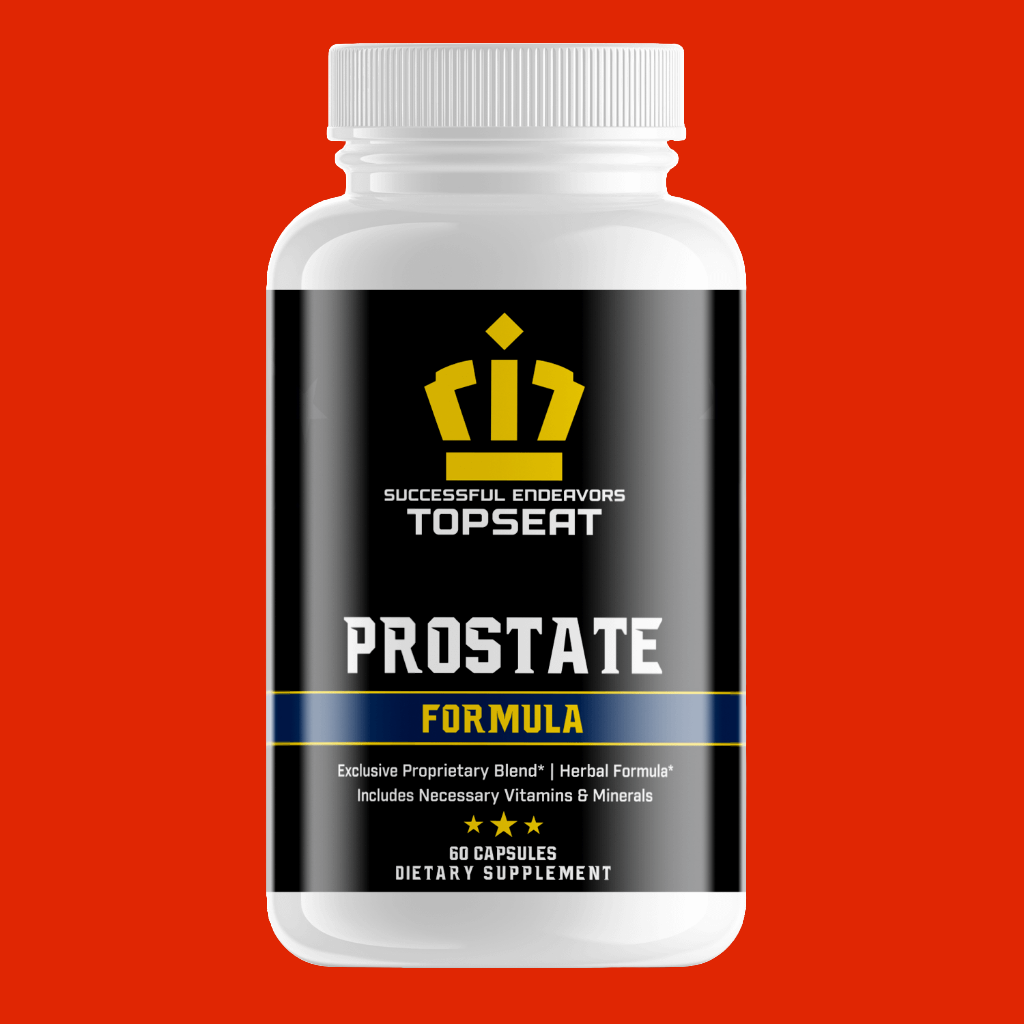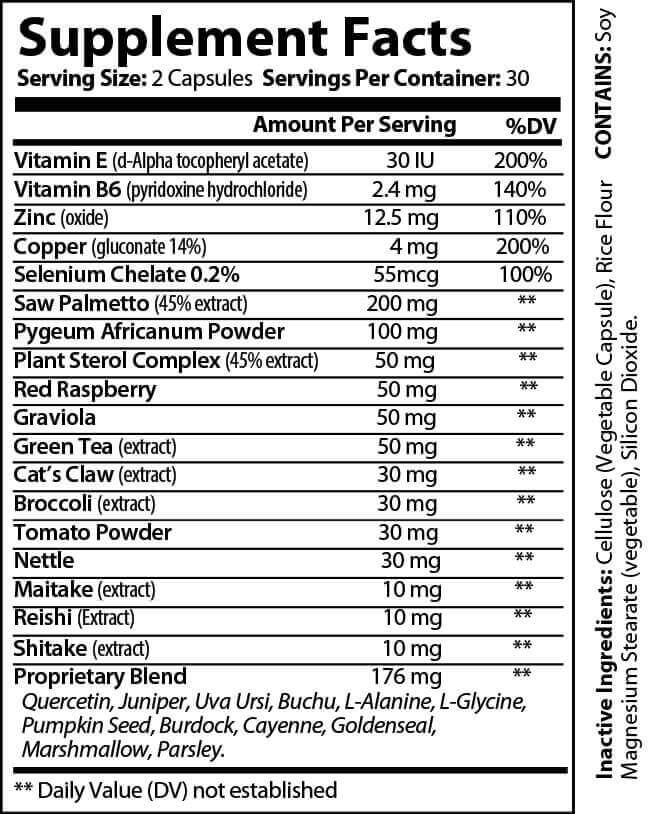Men’s Health
Topseat Prostate Regulator
Topseat Prostate Regulator
Couldn't load pickup availability
Potent, antioxidant-rich formula with green tea, red raspberry, and herbs.
| Formula Purposes & Benefits |
|
Prostate support, energy, cognition, mood, heart health. Science-backed, premium quality, tested. Exceptional standards. |
| Formula Ingredient Deck | Benefits Of Each Ingredient |
| Vitamin E |
|
| Vitamin B6 |
|
| Zinc |
|
| Copper |
|
| Selenium |
|
| Saw Palmetto |
|
| Pygeum Africanum |
|
| Red Raspberry |
|
| Graviola |
|
| Green Tea Extract |
|
| Cat’s Claw |
|
| Broccoli Extract |
|
| Tomato Extract/Lycopene |
|
| Stinging Nettle |
|
| Maitake, Reishi, Shitake |
|
| Quercetin |
|
| Juniper |
|
| Uva Ursi |
|
| Buchu |
|
| L-Alanine |
|
| L-Glycine |
|
| Pumpkin Seed |
|
| Cayenne Pepper |
|
| Goldenseal |
|
| Marshmallow |
|
| Parsley |
|
| Proper Use of This Supplement |
| Suggested Use: As a dietary supplement take two (2) veggie capsules once a day. For best results take two 20-30 minutes before a meal with an 8 oz glass of water, or as directed by your health care professional. |
| Our Formula Vs Other Formulas on the Market. | |
| 1. Uses third-party independently tested ingredients that are made in the USA, GMP certified, and made in an FDA registered facility. | 1. Source cheap ingredients from heavily polluted soils. Even “organic” supplements not third-party tested have been removed by FDA due to high levels of heavy metals. |
| 2. Uses high-quality nutraceuticals in an effective evidence-based and efficaciously dosed formula. | 2. Uses cheap sources of nutraceuticals that contain high amounts of fillers, heavy metals, and is formulated without evidence-based dosages. |
Sources
19.Salinas-Casado, J., Esteban-Fuertes, M., Carballido-Rodríguez, J., & Cozar-Olmo, J. M. (2020). Review of the experience and evidence of Pygeum africanum in urological practice. Revisión sobre la experiencia y evidencias del Pygeum africanum en Urología. Actas urologicas espanolas, 44(1), 9–13. https://doi.org/10.1016/j.acuro.2019.08.002
- Lim, S. H., & Choi, C. I. (2021). Potentials of Raspberry Ketone as a Natural Antioxidant. Antioxidants (Basel, Switzerland), 10(3), 482. https://doi.org/10.3390/antiox10030482
- Park K. S. (2010). Raspberry ketone increases both lipolysis and fatty acid oxidation in 3T3-L1 adipocytes. Planta medica, 76(15), 1654–1658. https://doi.org/10.1055/s-0030-1249860
- Rothenberg, D. O., Zhou, C., & Zhang, L. (2018). A Review on the Weight-Loss Effects of Oxidized Tea Polyphenols. Molecules (Basel, Switzerland), 23(5), 1176. https://doi.org/10.3390/molecules23051176
- Bogdanski, P., Suliburska, J., Szulinska, M., Stepien, M., Pupek-Musialik, D., & Jablecka, A. (2012). Green tea extract reduces blood pressure, inflammatory biomarkers, and oxidative stress and improves parameters associated with insulin resistance in obese, hypertensive patients. Nutrition research (New York, N.Y.), 32(6), 421–427. https://doi.org/10.1016/j.nutres.2012.05.007
- Haidari, F., Samadi, M., Mohammadshahi, M., Jalali, M. T., & Engali, K. A. (2017). Energy restriction combined with green coffee bean extract affects serum adipocytokines and the body composition in obese women. Asia Pacific journal of clinical nutrition, 26(6), 1048–1054. https://doi.org/10.6133/apjcn.022017.03
- Ueland, P. M., McCann, A., Midttun, Ø., & Ulvik, A. (2017). Inflammation, vitamin B6 and related pathways. Molecular aspects of medicine, 53, 10–27. https://doi.org/10.1016/j.mam.2016.08.001
- Bird R. P. (2018). The Emerging Role of Vitamin B6 in Inflammation and Carcinogenesis. Advances in food and nutrition research, 83, 151–194. https://doi.org/10.1016/bs.afnr.2017.11.004
- Mascolo, E., & Vernì, F. (2020). Vitamin B6 and Diabetes: Relationship and Molecular Mechanisms. International journal of molecular sciences, 21(10), 3669. https://doi.org/10.3390/ijms21103669
- Chilelli, N. C., Ragazzi, E., Valentini, R., Cosma, C., Ferraresso, S., Lapolla, A., & Sartore, G. (2016). Curcumin and Boswellia serrata Modulate the Glyco-Oxidative Status and Lipo-Oxidation in Master Athletes. Nutrients, 8(11), 745. https://doi.org/10.3390/nu8110745
- Barzegar, A., & Moosavi-Movahedi, A. A. (2011). Intracellular ROS protection efficiency and free radical-scavenging activity of curcumin. PloS one, 6(10), e26012. https://doi.org/10.1371/journal.pone.0026012
- Banik, U., Parasuraman, S., Adhikary, A. K., & Othman, N. H. (2017). Curcumin: the spicy modulator of breast carcinogenesis. Journal of experimental & clinical cancer research : CR, 36(1), 98. https://doi.org/10.1186/s13046-017-0566-5
- Suhett, L. G., de Miranda Monteiro Santos, R., Silveira, B., Leal, A., de Brito, A., de Novaes, J. F., & Lucia, C. (2021). Effects of curcumin supplementation on sport and physical exercise: a systematic review. Critical reviews in food science and nutrition, 61(6), 946–958. https://doi.org/10.1080/10408398.2020.1749025
- Pivari, F., Mingione, A., Brasacchio, C., & Soldati, L. (2019). Curcumin and Type 2 Diabetes Mellitus: Prevention and Treatment. Nutrients, 11(8), 1837. https://doi.org/10.3390/nu11081837
- Ashtary-Larky, D., Rezaei Kelishadi, M., Bagheri, R., Moosavian, S. P., Wong, A., Davoodi, S. H., Khalili, P., Dutheil, F., Suzuki, K., & Asbaghi, O. (2021). The Effects of Nano-Curcumin Supplementation on Risk Factors for Cardiovascular Disease: A GRADE-Assessed Systematic Review and Meta-Analysis of Clinical Trials. Antioxidants (Basel, Switzerland), 10(7), 1015. https://doi.org/10.3390/antiox10071015
- Evron, E., Juhasz, M., Babadjouni, A., & Mesinkovska, N. A. (2020). Natural Hair Supplement: Friend or Foe? Saw Palmetto, a Systematic Review in Alopecia. Skin appendage disorders, 6(6), 329–337. https://doi.org/10.1159/000509905
- Kwon Y. (2019). Use of saw palmetto (Serenoa repens) extract for benign prostatic hyperplasia. Food science and biotechnology, 28(6), 1599–1606. https://doi.org/10.1007/s10068-019-00605-9
- Gombart, A. F., Pierre, A., & Maggini, S. (2020). A Review of Micronutrients and the Immune System-Working in Harmony to Reduce the Risk of Infection. Nutrients, 12(1), 236. https://doi.org/10.3390/nu12010236
- Heffernan, S. M., Horner, K., De Vito, G., & Conway, G. E. (2019). The Role of Mineral and Trace Element Supplementation in Exercise and Athletic Performance: A Systematic Review. Nutrients, 11(3), 696. https://doi.org/10.3390/nu11030696
- Wang, N., Tan, H. Y., Li, S., Xu, Y., Guo, W., & Feng, Y. (2017). Supplementation of Micronutrient Selenium in Metabolic Diseases: Its Role as an Antioxidant. Oxidative medicine and cellular longevity, 2017, 7478523. https://doi.org/10.1155/2017/7478523
- Wichman, J., Winther, K. H., Bonnema, S. J., & Hegedüs, L. (2016). Selenium Supplementation Significantly Reduces Thyroid Autoantibody Levels in Patients with Chronic Autoimmune Thyroiditis: A Systematic Review and Meta-Analysis. Thyroid : official journal of the American Thyroid Association, 26(12), 1681–1692. https://doi.org/10.1089/thy.2016.0256
147.Benstoem, C., Goetzenich, A., Kraemer, S., Borosch, S., Manzanares, W., Hardy, G., & Stoppe, C. (2015). Selenium and its supplementation in cardiovascular disease--what do we know?. Nutrients, 7(5), 3094–3118. https://doi.org/10.3390/nu7053094
- Maywald, M., Wessels, I., & Rink, L. (2017). Zinc Signals and Immunity. International journal of molecular sciences, 18(10), 2222. https://doi.org/10.3390/ijms18102222
- Wessels, I., Rolles, B., & Rink, L. (2020). The Potential Impact of Zinc Supplementation on COVID-19 Pathogenesis. Frontiers in immunology, 11, 1712. https://doi.org/10.3389/fimmu.2020.01712
- Vahlensieck, W., Theurer, C., Pfitzer, E., Patz, B., Banik, N., & Engelmann, U. (2015). Effects of pumpkin seed in men with lower urinary tract symptoms due to benign prostatic hyperplasia in the one-year, randomized, placebo-controlled GRANU study. Urologia internationalis, 94(3), 286–295. https://doi.org/10.1159/000362903
- Hsu, Y. J., Huang, W. C., Chiu, C. C., Liu, Y. L., Chiu, W. C., Chiu, C. H., Chiu, Y. S., & Huang, C. C. (2016). Capsaicin Supplementation Reduces Physical Fatigue and Improves Exercise Performance in Mice. Nutrients, 8(10), 648. https://doi.org/10.3390/nu8100648
- Eichner E. R. (2016). Fighting Muscle Cramps With Two Spices and One Hot Fruit. Current sports medicine reports, 15(5), 304–305. https://doi.org/10.1249/JSR.0000000000000298
- Ziaei R, Foshati S, Hadi A, Kermani MAH, Ghavami A, Clark CCT, Tarrahi MJ. The effect of nettle (Urtica dioica) supplementation on the glycemic control of patients with type 2 diabetes mellitus: A systematic review and meta-analysis. Phytother Res. 2020 Feb;34(2):282-294. doi: 10.1002/ptr.6535. Epub 2019 Dec 4. PMID: 31802554.
- Chen, P., Zhang, W., Wang, X., Zhao, K., Negi, D. S., Zhuo, L., Qi, M., Wang, X., & Zhang, X. (2015). Lycopene and Risk of Prostate Cancer: A Systematic Review and Meta-Analysis. Medicine, 94(33), e1260. https://doi.org/10.1097/MD.0000000000001260
- Beynon, R. A., Richmond, R. C., Santos Ferreira, D. L., Ness, A. R., May, M., Smith, G. D., Vincent, E. E., Adams, C., Ala-Korpela, M., Würtz, P., Soidinsalo, S., Metcalfe, C., Donovan, J. L., Lane, A. J., Martin, R. M., ProtecT Study Group, & PRACTICAL consortium (2019). Investigating the effects of lycopene and green tea on the metabolome of men at risk of prostate cancer: The ProDiet randomised controlled trial. International journal of cancer, 144(8), 1918–1928. https://doi.org/10.1002/ijc.31929
- Shanbhag V. K. (2016). Lycopene in cancer therapy. Journal of pharmacy & bioallied sciences, 8(2), 170–171. https://doi.org/10.4103/0975-7406.171740
- Hetland G, Tangen JM, Mahmood F, Mirlashari MR, Nissen-Meyer LSH, Nentwich I, Therkelsen SP, Tjønnfjord GE, Johnson E. Antitumor, Anti-Inflammatory and Antiallergic Effects of Agaricus blazei Mushroom Extract and the Related Medicinal Basidiomycetes Mushrooms, Hericium erinaceus and Grifolafrondosa: A Review of Preclinical and Clinical Studies. Nutrients. 2020 May 8;12(5):1339. doi: 10.3390/nu12051339. PMID: 32397163; PMCID: PMC7285126.
- Mallard B, Leach DN, Wohlmuth H, Tiralongo J. Synergistic immuno-modulatory activity in human macrophages of a medicinal mushroom formulation consisting of Reishi, Shiitake and Maitake. PLoS One. 2019 Nov 7;14(11):e0224740. doi: 10.1371/journal.pone.0224740. PMID: 31697749; PMCID: PMC6837746.
- Afshar K, Fleischmann N, Schmiemann G, Bleidorn J, Hummers-Pradier E, Friede T, Wegscheider K, Moore M, Gágyor I. Reducing antibiotic use for uncomplicated urinary tract infection in general practice by treatment with uva-ursi (REGATTA) - a double-blind, randomized, controlled comparative effectiveness trial. BMC Complement Altern Med. 2018 Jul 3;18(1):203. doi: 10.1186/s12906-018-2266-x. PMID: 29970072; PMCID: PMC6029138.
- Dandare SU, Ezeonwumelu IJ, Shinkafi TS, Magaji UF, Adio AA, Ahmad K. L-alanine supplementation improves blood glucose level and biochemical indices in alloxan-induced diabetic rats. J Food Biochem. 2021 Jan;45(1):e13590. doi: 10.1111/jfbc.13590. Epub 2020 Dec 21. PMID: 33346923.
- Sekhar, R. V., Patel, S. G., Guthikonda, A. P., Reid, M., Balasubramanyam, A., Taffet, G. E., & Jahoor, F. (2011). Deficient synthesis of glutathione underlies oxidative stress in aging and can be corrected by dietary cysteine and glycine supplementation. The American journal of clinical nutrition, 94(3), 847–853. https://doi.org/10.3945/ajcn.110.003483
- Razak, M. A., Begum, P. S., Viswanath, B., & Rajagopal, S. (2017). Multifarious Beneficial Effect of Nonessential Amino Acid, Glycine: A Review. Oxidative medicine and cellular longevity, 2017, 1716701. https://doi.org/10.1155/2017/1716701
- Bonaterra GA, Bronischewski K, Hunold P, Schwarzbach H, Heinrich EU, Fink C, Aziz-Kalbhenn H, Müller J, Kinscherf R. Anti-inflammatory and Anti-oxidative Effects of Phytohustil® and Root Extract of Althaea officinalis L. on Macrophages in vitro. Front Pharmacol. 2020 Mar 17;11:290. doi: 10.3389/fphar.2020.00290. PMID: 32256361; PMCID: PMC7090173.
- Goldenseal. (2021). In Drugs and Lactation Database (LactMed). National Library of Medicine (US).
- Mandal, S. K., Maji, A. K., Mishra, S. K., Ishfaq, P. M., Devkota, H. P., Silva, A. S., & Das, N. (2020). Goldenseal (Hydrastis canadensis L.) and its active constituents: A critical review of their efficacy and toxicological issues. Pharmacological research, 160, 105085. https://doi.org/10.1016/j.phrs.2020.105085
- Mara de Menezes Epifanio, N., Rykiel Iglesias Cavalcanti, L., Falcão Dos Santos, K., Soares Coutinho Duarte, P., Kachlicki, P., Ożarowski, M., Jorge Riger, C., & Siqueira de Almeida Chaves, D. (2020). Chemical characterization and in vivo antioxidant activity of parsley (Petroselinum crispum) aqueous extract. Food & function, 11(6), 5346–5356. https://doi.org/10.1039/d0fo00484g
- Jovic, T. H., Ali, S. R., Ibrahim, N., Jessop, Z. M., Tarassoli, S. P., Dobbs, T. D., Holford, P., Thornton, C. A., & Whitaker, I. S. (2020). Could Vitamins Help in the Fight Against COVID-19?. Nutrients, 12(9), 2550. https://doi.org/10.3390/nu12092550
- Traber, M. G., & Atkinson, J. (2007). Vitamin E, antioxidant and nothing more. Free radical biology & medicine, 43(1), 4–15. https://doi.org/10.1016/j.freeradbiomed.2007.03.024
- Wu, D., & Meydani, S. N. (2014). Age-associated changes in immune function: impact of vitamin E intervention and the underlying mechanisms. Endocrine, metabolic & immune disorders drug targets, 14(4), 283–289. https://doi.org/10.2174/1871530314666140922143950
- De la Fuente, M., Hernanz, A., Guayerbas, N., Victor, V. M., & Arnalich, F. (2008). Vitamin E ingestion improves several immune functions in elderly men and women. Free radical research, 42(3), 272–280. https://doi.org/10.1080/10715760801898838
- Browne, D., McGuinness, B., Woodside, J. V., & McKay, G. J. (2019). Vitamin E and Alzheimer's disease: what do we know so far?. Clinical interventions in aging, 14, 1303–1317. https://doi.org/10.2147/CIA.S186760
Serving Size: 2 Capsules;
Capsules Per Container: 60;
Bottle Color: White;
Bottle Size: 175cc;
Lid Color: White

* These statements have not been evaluated by the Food and Drug Administration. This product is not intended to diagnose, treat, cure or prevent any disease.






